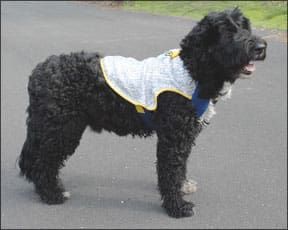[Updated July 16, 2018]
DOGS AND HEAT STRESS: OVERVIEW
1. Never leave your dog in a car parked in the sun.
2. Watch for symptoms of heat stress and if they occur, give immediate first aid and go to the nearest veterinary clinic.
3. When temperatures climb, provide extra drinking and splashing water.
4. Plan exercise and outdoor play when temperatures are coolest.
Hot weather spells trouble for dogs. Because they can’t release heat by sweating the way humans do, heat and humidity can raise canine body temperatures to dangerous levels. Heat stroke kills, and heat stress (a less severe condition) can take a serious toll on a dog’s health. Unfortunately, heat-related problems are among the most common summer canine ailments.
Conscientious caregivers plan ahead and do everything they can to keep their dogs safe in the heat. Here are some strategies and products for helping hot dogs chill out.
To reduce canine summer heat stress, let your dog become accustomed to climate changes naturally and gradually, the way animals adapt in the wild. Schedule long walks for the coolest time of the day but spend a few minutes outdoors during warmer hours, too. Unless your climate is dangerously hot, your dog can be comfortable for short periods.

Summer daytime temperatures are coolest at dawn and dusk. Just after sunrise and just before sunset are the best times to take your dog for a run or a long walk. Humidity matters as much as temperature; in fact, a combination of high humidity and moderate temperatures can stress a dog as much as mid-day sun. Always watch for signs of stress. Dogs pant to release heat, so if your dog pants more heavily than usual, slow down, stop, find shade, offer water, and rest for a while.
Ideal dog exercise locations are shaded parks or lawns near a pond, river, creek, or pool. Beaches are usually cooler than inland areas, and both lakes and oceans (assuming conditions are safe for swimming) allow dogs to cool off whenever they like. Whether your dog is a wader or swimmer, let him rest in the shade after playing in water. At home, a plastic wading pool can be a perfect place to dip and chill.
Whenever temperatures climb, provide extra drinking water. Your dog’s panting cools him by releasing body heat, but this process also can dehydrate his body.
To encourage a hot dog to drink on hot days, resupply his cold water. Some people fill a dog bowl or bucket and freeze it overnight. As it melts during the day, it provides a steady supply of refreshing, cold water (check to make sure it melts quickly enough to provide as much water as he might wish to drink).
Alternatively, or in addition, freeze or simply chill water in the refrigerator in a plastic water bottle and add the melting or chilled contents to your dog’s water periodically throughout the day. Change your dog’s water more often during hot weather and add ice cubes to your dog’s bowl.
Many hot dogs enjoy curling up with a nice cold ice pack. A frozen plastic water bottle stays cool for hours. Dogs who use frozen water bottles as pillows cool down quickly, since blood circulates close to the surface at the neck and throat.
For summer comfort, nothing beats the shade of trees, so as you plan the day’s activities, look for parks, play areas, picnic tables, and hiking trails that are sheltered from direct sunlight. At home, if your dog doesn’t have a dog door or easy access in and out, be sure he has shade to rest in and ample water supplies. The sun’s angle changes with the seasons, so be aware of shifting shade patterns. Providing shade is most important between 10 a.m. and 4 p.m.
Ventilation and air circulation are crucial when dogs are confined to pens, crates, and kennels. Solid walls interfere with air circulation while chain link fencing, screens, or mesh fabric allow the air to move. Shade covers help reduce heat loads, and fans that circulate air have a cooling effect. Study the forecast as you schedule play dates and outdoor events. When heat and humidity are high, save outdoor activities for breaks in the weather or days with lower humidity.
As all Whole Dog Journal readers know, it’s never safe to leave a dog in a parked vehicle. The inside of a car parked in the sun, even with its windows down, can increase by several degrees per minute, quickly reaching 125°F or even 150°F.
Keep your dog well groomed, with frequent brushing to remove dead hair, especially the undercoat. Some long-haired or heavy-coated dogs feel much more comfortable with short summer cuts, keeping in mind that dogs whose coats are shaved or cut very short are at risk for sunburn.
Heat Stress Risks to Dogs
Heat stress, heat exhaustion, and heat stroke or heat prostration are increasingly severe levels of the same basic condition.
Any dog can suffer from heat stress, but dogs who are most susceptible include the very young and old; any dog with a history of heat stress; breeds with flat faces or short noses; and dogs who are overweight, physically inactive, have cardiovascular disease, or respiratory problems. Some prescription drugs may increase the risk.
Though dogs cannot sweat and humans do sweat, heat risk factors between us are quite similar.
The symptoms of heat stress include profuse panting, salivation, an anxious expression, staring without seeing, failing to respond to commands, skin that is warm and dry, fever, rapid pulse, fatigue or exhaustion, muscular weakness, and physical collapse.
The symptoms of heat stroke or heat prostration can include a warm nose and foot pads, glazed eyes, heavy panting, rapid pulse, a dark red tongue, fever, dizziness, vomiting or diarrhea, immobility, and unconsciousness. Brain damage occurs when the body’s temperature reaches 106° to 107°F. A dog’s normal temperature is 100.5° to 101.5°F.
If your dog experiences any of the above symptoms, provide immediate first aid. Your rapid response may save your dog’s life.
Reduce your dog’s temperature by moving her into shade and immersing her gradually into cool water, such as in a stream, pond, fountain, horse trough, bath tub, or wading pool. Otherwise, wet the dog thoroughly, pouring a continuous stream of cool water over her body, beginning with the head and extremities, from a hose, watering can, bottle, or pan. If possible, apply ice packs to her head and neck. Apply wet towels to her abdomen, groin, legs, head, and neck.
If you can, take your dog’s temperature and continue applying cool wet towels until it returns to normal.
As soon as possible, take your dog to a veterinary clinic. Even if she seems to have recovered, her body temperature could increase again; heat stress always carries a risk of brain damage; and depending on the dog’s age, physical condition, and the amount of time spent with an elevated temperature, complications can occur.
Cooling Vests for Dogs Available
There’s no shortage of special equipment to help keep dogs cool. Pet supply catalogs and websites sell everything from cooling crate pads to water-retaining scarves, battery operated or solar powered fans, mesh beds, solar shade sheets, special hats, and cooling mats.
Now cooling vests are becoming popular. Made from different materials and operating on different cooling principles, these garments are designed to keep dogs from overheating.
Do they work? To help us find out, we recruited Bridgeport, Connecticut, dog trainer Deborah Lee Miller-Riley and her Portuguese Water Dog, Skyler, to test some popular models. Miller-Riley competes with her dogs in water sports and runs Splash Camps and Splash Workshops across the country (see k9watersports.com for more information).
Skyler is an 11-year-old male who weighs 61 pounds and had a 3-inch-thick wavy coat until we finished our tests, when he got a short, cooling summer cut.
Each vest was tested on a sunny, warm day with some cloud cover, in temperatures ranging from 83 to 85°F, humidity near 45 percent, and very mild winds. The walks lasted 30 to 35 minutes for each vest tested, ending at a stream where Skyler cooled his legs before returning by the same route.
All of the vests come in different sizes, with size charts based on weight and measurements such as girth (chest at its widest part), neck, back length, or length from front leg to back leg. Skyler’s correct size, depending on the manufacturer, was medium, large, or extra large. Because his measurements often fell near a size change, we supplied all of his statistics when ordering, asking the seller to send his best size. Two had to be returned for size replacement, and one more should have been.
Miller-Riley’s observations apply to Skyler’s experiences with the vests. Several of the vests reviewed here were designed for or are used by military, search and rescue, police, and working dogs. Results may vary for smaller or larger dogs, dogs of different breeds, engaged in different activities, or in other climates.
RPCM Cooling Vest
RPCM stands for Glacier Tek’s Renewable Phase Change Material, which is made from food-grade fats and oils. RPCM cool packs recharge in 20 minutes in ice water. Inserted into the Vest, they are said to maintain a steady 59°F temperature for two to three hours, even in 100-degree weather. Glacier Tek also offers a Chilly Pad for dogs to lie on.

According to its manufacturer, the vest was developed for firefighters and adapted for military working dogs in Iraq. The black nylon vest comes in two sizes, Chilly Dog ($159) and Chilly Pup ($129). Skyler wore the larger size, which adjusts for chest girths of 28 to 46 inches.
Miller-Riley reports, “We tested this vest when the temperature was 82° and the humidity 56 percent. The cool packs cover the abdomen, and the vest is held in place with straps over the chest and back. There was no change in Skyler’s panting from start to finish. He did not go for a swim, just got his feet wet. His skin stayed cool under the rib cage covered by the vest.
“This product, which seems to be designed only for large dogs, is medium-weight and simple to use, but you have to cool or refrigerate the gel-like cells. I didn’t like its large plastic snaps resting on my dog’s spine, though he didn’t seem to care.”
Chillybuddy
A light-weight mesh jacket made of woven plastic with an aluminized finish (a fabric originally designed for greenhouse shade cloths), this highly reflective vest is lined with breathable cotton mesh.

Chillybuddy comes in seven sizes, from petite to extra-extra large. Using Skyler’s neck and girth measurements, we ordered size medium, which cost $33. We should have used the third measurement that
Chillybuddy uses to determine size; the length of the dog’s back. As you can see in the photo above, the size we ordered was too short to cover Skyler’s back, and we ran out of time to return this and order the correct size. A company representative belatedly suggested using the back length as the critical measurement, as the neck and girth straps are highly adjustable.
According to Chillybuddy’s maker, the vest can reduce a dog’s coat temperature almost 30 percent on a 90-degree day. Soaking it before use dampens the cotton lining, which holds water for evaporative cooling. Miller-Riley says, “It was slightly cooler (72 degrees) when we tested this product, so we walked for an hour rather than our usual 30 minutes. Skyler stayed comfortable throughout.
“This coat is easy to use, lightweight, and it folds up and packs well. The shade cloths I use for my tent and car are made of the same kind of fabric, which really reflects heat, and the mesh circulates air well. A full strap goes around the belly, anchored with belt loops, and Velcro strips allow further adjustment.
“However, both the front and back kept flipping up and always seemed to need adjusting. Perhaps this would not be the case if we had ordered the correctly sized coat.”
Beware of Cooling Your Dog in Bodies of Water: Blue-Green Algae Can Kill
Water is wonderful, but not if it’s toxic. When conditions promote the growth or “bloom” of toxic blue-green algae in lakes and ponds, animals can die. In the U.S. and Canada, blue-green algae blooms have claimed the lives of deer, elk, livestock, and dogs soon after drinking algae-infected water.
Get the full scoop on blue-green algae here.
Conclusions on Cooling Your Dog
At the end of their research, Miller-Riley concluded, “All in all, Skyler seems to be cooled best by jumping into a body of water or having a gallon jug of water poured over him. I am not sure I would put my money down for any of these coats. However, the Radic vest from Japan was affordable, easy to use, provided some cooling, and my dog didn’t have to get wet for it to be effective.
“Most wild canines do not venture forth in the hottest part of the day. They seek cool spots in the earth or under vegetation until the sun goes down. It’s wonderful that so many products are being developed to help working dogs in adverse conditions, but where pets are concerned, keeping them cool involves a certain amount of common sense. Why drag a dog out into the heat unless it’s to go for a swim or a wade?”
CJ Puotinen is author of The Encyclopedia of Natural Pet Care, Natural Remedies for Dogs and Cats, and other books. She lives in New York with her husband, a Labrador, and a tabby cat.






